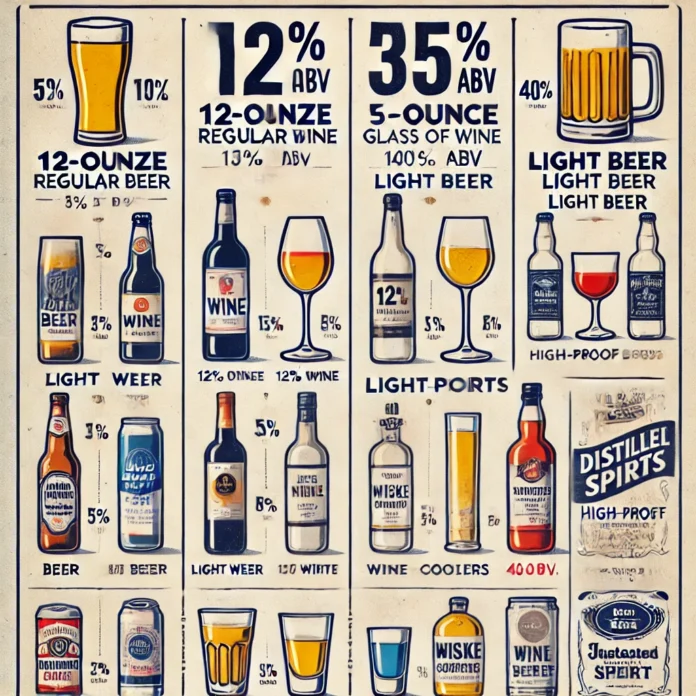Understanding the standard amount of alcohol in a drink is essential for making informed decisions about alcohol consumption. This knowledge helps in moderating intake, ensuring responsible drinking, and preventing health issues associated with excessive alcohol consumption. This article delves into the concept of standard drink measurements, explores the different types of alcohol and their respective contents, and examines the health implications of varying alcohol consumption levels.
Understanding Standard Drink Measurements
A standard drink is a measure used to quantify alcohol consumption, helping individuals keep track of their intake. In the United States, a standard drink typically contains about 14 grams (0.6 ounces) of pure alcohol. This amount is found in:
- 12 ounces of regular beer with about 5% alcohol content.
- 5 ounces of wine with approximately 12% alcohol content.
- 1.5 ounces of distilled spirits or liquor (like vodka, whiskey, or rum) with about 40% alcohol content.
These measurements serve as a guideline for moderate drinking, defined by the Centers for Disease Control and Prevention (CDC) as up to one drink per day for women and up to two drinks per day for men. However, it’s important to note that the alcohol content can vary significantly across different types of beverages and brands.
Types of Alcohol and Their Alcohol Content
Alcoholic beverages come in various forms, each with different alcohol content. The main types include beer, wine, and spirits. Here’s a closer look at each:
-
Beer:
- Regular Beer: Typically contains about 5% alcohol by volume (ABV). A 12-ounce can or bottle of regular beer is considered one standard drink.
- Craft Beers: These can have higher ABV, often ranging from 5% to 12% or more. It’s important to check the label, as a single bottle of craft beer can sometimes equate to two or more standard drinks.
- Light Beers: Generally contain less alcohol and fewer calories than regular beers, often around 4% ABV.
- Domestic Beer: Commonly found beers in the U.S. like Bud Light, which has around 4.2% ABV.
- Different Types of Beer: Variations such as lagers, ales, stouts, and IPAs each have distinct flavors and alcohol contents. For instance, a strong IPA might have an ABV of 7% or higher, while a light lager might be around 4%.
-
Wine:
- Glass of Wine: A standard 5-ounce serving of wine typically contains about 12% ABV.
- White Wine: Generally has a slightly lower ABV than red wine, usually around 11-13%.
- Wine Coolers: Often have lower ABV, around 4-6%, and are typically served in larger quantities.
- Type of Alcohol in Wine: Fortified wines like port or sherry have higher alcohol content, often between 15-20% ABV.
- Standard Bottle of Wine: Contains about 750 ml, which is roughly five standard drinks.
-
Spirits:
- Distilled Spirits: These include vodka, whiskey, rum, gin, and tequila. A standard serving is 1.5 ounces with about 40% ABV (80 proof).
- Higher Alcohol Content: Some spirits, like cask-strength whiskey or overproof rum, can exceed 50% ABV, making them much stronger than typical spirits.
- Shot of Liquor: A standard shot is 1.5 ounces. Popular shots include vodka, whiskey, and tequila.
- High-Proof Liquors: Such as Everclear, which can be as high as 95% ABV.
- Different Types of Liquor: Each spirit has unique properties and ABV. For example, a shot of whiskey typically has around 40% ABV, whereas a vodka shot might range from 35-50% ABV depending on the brand.
- Alcohol Strength and Proof: The proof system is used in the United States to denote alcohol content, where the proof is double the ABV (e.g., 40% ABV is 80 proof).
Measuring Alcohol Content
Accurately measuring the alcohol content in beverages is crucial for understanding consumption levels. Alcohol content is typically expressed in terms of:
- Ounces of Alcohol: The actual volume of pure alcohol in a drink.
- Grams of Pure Alcohol: One standard drink in the U.S. contains about 14 grams of pure alcohol.
- Percent Alcohol: The alcohol by volume (ABV) percentage indicates how much of the liquid is alcohol.
- Alcohol Units: In some countries, alcohol units are used to measure consumption. For instance, in the UK, one unit equals 10 milliliters (8 grams) of pure alcohol.
When consuming mixed drinks or cocktails, it’s important to account for the total alcohol content, which may come from multiple sources. For example, a cocktail containing two ounces of 40% ABV spirit and a liqueur with 20% ABV will have a higher overall alcohol content than a single serving of either component.
Factors Affecting Alcohol Content
Several factors can influence the alcohol content in beverages, including:
- Type of Alcohol: Different beverages have varying alcohol concentrations. For example, spirits generally have higher ABV than beer or wine.
- Preparation Method: The way a drink is made can affect its alcohol content. For instance, cocktails with multiple alcohol components or mixers can increase the total alcohol content.
- Serving Size: Larger servings naturally contain more alcohol. A pint of beer (16 ounces) has more alcohol than a standard 12-ounce serving.
- Brand and Recipe: Different brands and recipes may have varying ABV levels. Craft beers and specialty wines often have higher alcohol content than their mass-produced counterparts.
Understanding these factors helps individuals make informed choices about their alcohol consumption.
Health Implications
Alcohol consumption has various health implications, both positive and negative, depending on the amount and frequency of intake.
- Moderate Drinking:
- Moderate alcohol consumption has been associated with certain health benefits, such as a reduced risk of heart disease. However, these benefits are typically observed in older adults and should not be a reason to start drinking if one does not already do so.
- Excessive Alcohol Use:
- Blood Alcohol Content (BAC): The concentration of alcohol in the bloodstream. Higher BAC levels can impair judgment, coordination, and reaction times, leading to accidents and injuries.
- Alcohol Poisoning: Consuming large amounts of alcohol in a short period can lead to alcohol poisoning, a potentially life-threatening condition.
- Alcohol Abuse and Addiction: Regular excessive drinking can lead to alcohol use disorder (AUD), characterized by an inability to control drinking despite negative consequences.
- Higher Alcohol Content: Drinks with higher alcohol content can increase the risk of alcohol poisoning and other health issues, especially when consumed rapidly.
- Drunk Driving: Consuming alcohol impairs driving abilities and increases the risk of accidents. Legal limits for BAC vary by country, but even small amounts of alcohol can affect driving skills.
- Long-term Health Risks:
- Chronic heavy drinking can lead to liver disease, cardiovascular problems, digestive issues, and an increased risk of certain cancers.
- Mental Health: Excessive alcohol use can exacerbate mental health issues like depression and anxiety.
- Binge Drinking: Defined as consuming five or more drinks on a single occasion for men, and four or more for women, binge drinking significantly increases the risk of long-term health problems.
Understanding these health implications underscores the importance of moderation and awareness of alcohol consumption.
Legal and Social Considerations
- Legal Limit: Different countries have various legal limits for BAC when it comes to driving. In the U.S., the legal limit is typically 0.08%, but it can be lower for commercial drivers and individuals under the legal drinking age.
- Human Services and Health Guidelines: Organizations like the U.S. Department of Health and Human Services and the National Institute on Alcohol Abuse and Alcoholism provide guidelines on safe alcohol consumption.
- Social Drinking: Events like happy hours and parties often encourage social drinking. It’s important to be aware of how much one is drinking in these settings to avoid overconsumption.
Conclusion
Knowing the standard amount of alcohol in a drink is crucial for responsible drinking and making informed choices about alcohol consumption. By understanding the different types of alcohol, their respective contents, and the health implications associated with varying levels of consumption, individuals can better manage their drinking habits. Always remember that moderation is key, and when in doubt, it’s best to consult health professionals for advice tailored to individual circumstances.
This comprehensive overview of alcohol content across different beverages aims to provide valuable insights into responsible drinking practices and the importance of understanding what constitutes a standard drink.





